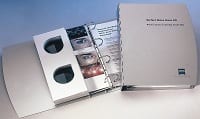Seven Ways to Present AR to Patients Strong sellers of AR share the positioning and phrasing they use to explain AR to patients. By Barbara Anan Kogan, O.D. Anti-reflective (AR) sales have grown in the United States over the past 10 to 12 years from 3.5 percent to 17.1 percent in 1998, according to a survey of the 54-member AR Council. Lee Anderson, the Council's executive director, attributes "technology as a way of life responsible for 92 percent of Japanese prescriptions being AR coated, and the desire for quality eyewear and lenses for over 60 percent penetration into the European market." Sandy Kinard, customer service rep at Sealey Optical, a division of the 80 nationwide Southern Optical/Essilor labs, notes a 33 percent rise in the number of AR orders in 1999, which she thinks is due to the newer coating technologies and ease of keeping the lens clean. In her 22 years optical lab experience, Kinard has seen the types and quality of AR coatings progress to include in-house and special coating facilities. "Package deals, which include UV, scratch, and AR, are commonplace, especially with progressive orders," says Kinard. Walman Optical's 28 labs nationwide have also seen an increase in orders within the last year. "People drive more in the night-time in winter, and they experience headlight glare, especially seniors," says, Ruby Patton, finishing lab supervisor, which is why she sees more orders in winter. When optometrists and opticians across the country train their staffs about AR, the sales increase. In fact, patient loyalty for repeat orders of AR reportedly range from 50 to 75 percent. Mechanics of AR's Benefits "Among the benefits of AR is an increase in light transmission by approximately 10 percent," according to Larry Wallace, O.D., president of the College of Syntonic Optometry, whose members use light therapy with combinations of colored lens filters in the treatment of visual and systemic disorders. "Therapeutic use of different colors of anti-reflective coatings on eyeglass lenses, such as blue/green, purple, or rose, can provide benefits to patients," adds Wallace, who is also a practitioner in Ithaca, N.Y. Herndon, Va. optometrist Tom Finley, also finds AR "improves contrast sensitivity by reducing glare and gets more light into the eye to enable patients to see a lot sharper." "Since normal lenses have reflections off of two surfaces, especially depending upon the prescription, AR reduces those reflections and is just a more comfortable lens in general," says Howard Kahn, O.D. of Virginia Beach. "AR uses the same technology as high quality camera and binocular lenses to allow 99.5 percent of the light through the lens," adds John Morley, general manager at one of eight of Albert Voorthius' optical shops in an exclusive Washington, DC area.
Tips for Presenting AR Given such benefits, it's little surprise that there are multiple ways to present AR to patients-and multiple reasons why it benefits wearers in several different situations. Here's how some of your peers are presenting those features and benefits. 1. Cosmetics "Cosmetics are important here in Berkeley," says northern California optometrist Philip Schletter, who explains to his patients that "AR will provide less magnification of your eyeglass lenses while increasing the amount of light that goes into your eyes." Offering AR to high myopes and high hyperopes as a coating for the thinnest lens available contributes to the sale of AR to more than 65 percent of patients in Schletter's practice. "Aspheric lenses and AR's mechanics offer patients a better quality of visual acuity," he adds. No-lens look. "The lens in your eyeglasses almost disappears so people can see you and you can see them," says Morley. The two key ingredients of anti-reflective coating, are "to look well and see well," according to Morley, who has been an optician for 37 years. All occasions. "All of our customers want to look good," says Bill Schneider, a Shawnee Mission, Kan. optician, about his upper-end clientele. With the professionals he draws from in this Midwest town, he says it's important, for example, that "AR makes you look good when you are having your picture taken with your glasses on. It's an all-occasion lens," he adds, which is why his success rate is over 90 percent. On camera. "Cutting down on reflections and improving visual clarity are important for someone like you," Robert Heller, O.D., tells his San Diego patients who are "in the news, on TV, in the theater, and have their pictures taken with glasses. We have between 70 and 80 percent of our patients wearing the coating."
Two markets. AR's improvement in cosmetic appearance works in two markets for Don Robbins, O.D., from Cleveland, Ga. "In your occupation, you need to look good," Robbins tells his patients who are in sales or those who do public speaking. "I consider the moderate myope who is a full-time wearer of glasses a candidate for AR; even though his lenses aren't quite as thick as a high myope, he can still look good," says Robbins. Saying more about AR to existing patients versus those who, for example, are adapting to eyeglasses for the first time has proven more successful for this optometrist. Proper care. AR is especially beneficial for the "stronger Rx's because you can get rid of glare when you are looking out of your glasses and, when people are looking at you," advises Michelle Garrison, Pearle Vision Express manager of three stores in the Minneapolis-St. Paul area. Since the coatings are "perfected now, compared with five to six years ago, AR is easier to present to the customer," notes Garrison. She emphasizes the importance of proper care of an AR-coated lens with her customers. 2. Long winters "Improved visibility occurs at night when your glasses are AR coated," Wallace tells his upstate New York patients. This is especially important during the long winters with extended darkness and glare from snow. Halogen beams. Finley tells his suburban Washington, D.C. patients that "night driving becomes more hazardous with the glare from ongoing car headlights, which now have bright halogen beams." Street lights. "Cutting down on reflections from street lights and car headlights are accomplished with an AR coating," Morley tells his customers. 3. Computer Glare Lighting. With AOL's headquarters nearby, computer users include most of Finley's Herndon, Va. office. Since many of today's computers have glare screens, Finley tells his patients that additional sources of computer glare are "from the overhead fluorescent lights in the office or school, and also from side lighting at any location, including home computers." The anti-reflective coating for these patients is "doctor suggested," according to Finley, and lens options are reinforced at all staff meetings. Screens. Older computer screens had a lot of reflection, necessitating use of a glare shield. New screens have much less glare, but patients need to be reminded that reflections still exist, says Kahn, who authored the book, Vision and Video Display Terminals, published by the Optometric Extension Program. PAL wearers. "I especially recommend AR to the progressive bifocal user while at the computer to reduce glare from the screen, windows, walls, and other external sources," says Robbins. UV. Just north of California's Silicone Valley, Berkeley's Schletter combines UV and AR to aid in reducing eyestrain from computer use. Since a high percentage of his patients work from their home offices, he advises AR as another protection against your glasses getting scratched. 4. Glare from Cataracts Acuity. "Reduced visual acuity from cataracts, no matter how early, can be improved with an AR coating on your glasses," Finley tells his patients. Glare. "And, as a cataract matures, glare becomes an increasingly annoying problem," Robbins tells his suburban Georgia state capitol patients. Flare. "When you have a cataract, the way you see won't be quite as sharp, and you will experience a flare around lights and objects," explains Akira Tajiri, O.D. of Reedley, Calif. "The AR coating can reduce that flare," he says. 5. Contact Lens Wearers Crispness. "When a patient wears RGPs, he is accustomed to seeing crisper than when looking through a hydrogel contact lens," Tajiri says, and he tells his patients that, "In addition to seeing better with an anti-reflective coating on your glasses when you are not wearing your contact lenses, people will be able to see your eyes better." Peripheral vision. I used to tell my contact lens wearers that "the coating enables you to see so sharply and have that side vision just like when you are wearing your RGPs." 6. Visual Dysfunctions Prism. Since approximately 60 percent of Tajiri's patients wear vertical prism for visual imbalances, he also recommends AR as an option to see clearer. Visual therapy. And, for children and adults in vision therapy, the AR coating "will give you a more natural, easier way of seeing, especially as your eyes begin to move more smoothly from the work you're doing in VT," he says. 7. Communication Skills "Generally, when people have to see to converse with one another, they don't communicate as well when they can't see each other," Kahn tells his patients. These communication skills can be enhanced when there is an anti-reflective coating on the glasses so, "you can see and be seen." And that is, after all, the goal of every optometrist and optician...to help patients see better and look better. EB
|
Article
Seven Ways to Present AR to Patients
Strong sellers of AR share the positioning and phrasing they use to explain AR to patients.
Eyecare Business
March 1, 2000






